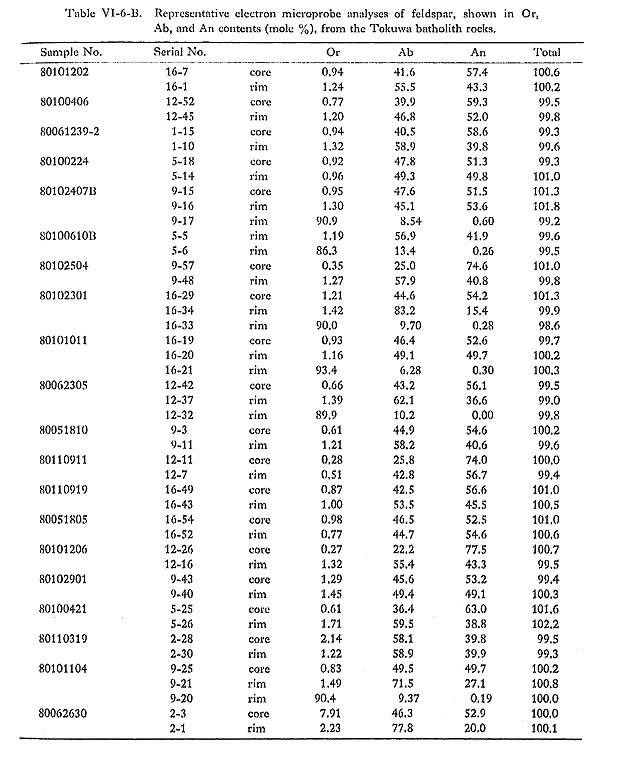CHAPTER VI
Mineralogy of the Tokuwa Batholith Rocks
4) Feldspar
|
Plagioclaae generally occurs as a euhedral to subhedral, albite- or Carlsbad-twinned crystal of up to 5 mm in length, but generally about 1 mm long. It shows a remarkable zonal structure with normal and, rarely, oscillatory zonings. Plagioclase grains commonly have normal zonal patterns with a calcic core (An60-50) and sodic rim (An40-30) (Figs. VI-1-D, -E, and -F). The calcic plagioclase (An70±) observed at the core of phenocrystic crystals (>1.5 mm in length) or as inclusions in hornblende may also be relicts of early crystallized grains. Plagioclase that probably crystallized together with clinopyroxene has a high An content. Such plagioclase (An70-50) in magnetite-series rocks shows higher An contents than plagioclase (An60-40) in ilmenite-series rocks. Because the chemistry of plagioclase in the two series of rocks is significantly different, melt compositions were probably different before it crystallized. Some large phenocrystic plagioclase has lines of tiny inclusions along the crystal growth lines. Some plagioclase is sericitized, especially in the core. Plagioclase crystals also occur as inclusions within alkali feldspar grains.
Alkali feldspar occurs as a subhedral crystal of up to 3 mm in size or as an interstices-filling texture. Microperthite and myrmekite are occasionally observed between alkali feldspar and plagioclase. The microperthite has film-like or string-like shape, and the width of the sodic phase is generally less than 10 µm. No cross-hatched twinning has been observed. Its orthoclase structure was established by X-ray diffraction using the method of Wright (1968). Forty-six representative chemical compositions of feldspar samples are given in Tables VI-6-A and -B. Anorthite contents in plagioclase decrease with the increase in SiO2 contents of host rocks (Fig. VI-10). The maximum frequency of An contents in the specimens is estimated to be about An50. Plagioclase in gabbroic to dioritic rocks in the batholith is considered to be a cumulus mineral based on its relatively low An content (Fig. VI-10) and positive Eu anomaly, as will be discussed in Chapter VII.
Orthoclase contents in alkali feldspar increase with the increase in SiO2 of host rocks, whereas Ab and An contents in alkali feldspar decrease as SiO2 in host rocks increases (Fig. VI-11), Orthoclase contents in plagioclase in the Tokuwa batholith rocks are generally low in the core and increase toward the rim, nearly in proportion to the decrease in An, reaching the maximum value at a point between the core and the rim. This phenomenon has been reported from some other Japanese granitoids, such as the Omine acid rocks (Kawasaki, 1980), the Okueyama batholith (Takahashi, 1980), and granitoids of the Ryoke and the San'yo Belts (Sakiyama, 1982, pers. comm.). It is thought that this point between core and rim probably represents the period when K-feldspar joined the crystallization after the liquid reached the cotectic line in the ternary system of An-Ab-Or.
The crystallization temperatures of plagioclase can be estimated from this inflection point toward the rim by examining the zonal patterns of Or in plagioclase (Takahashi, 1980). According to plagioclase thermometry (Takahashi, 1980), K-feldspar began to crystallize with plagioclase (An29.0-47.9 Ab38.9-49.5 Or2.1-1.6) at 770° to 760°C, and plagioclase (An27.1-15.4 Ab71.4-83.2 Or1.5-1.4) ceased to crystallize from the magma at 730° to 700°C. K-feldspar in both series began to crystallize at 770° to 740°C, and plagioclase in both series stopped crystallizing at 730° to 700°C. The accuracy of the thermometer is ±30°C, based on the standard deviations corresponding to each experimental temperature and the temperature estimation error for heating experiments (Takahashi, 1980). Therefore the temperature difference between feldspars in magnetite-series and ilmenite-series rocks of the Tokuwa batholith is considered to be within the range of error. |





